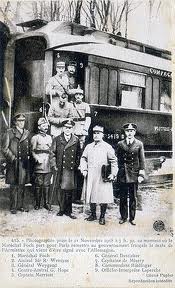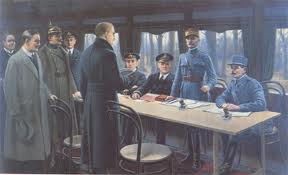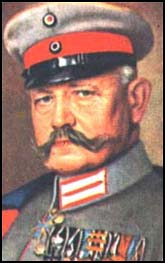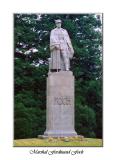
Near Compiègne, in the middle of a forest, is one of the most important Great War locations: the place where men sitting around a table decided that the killing would end. For four years men had lived like animals in holes in the ground. They had endured pain, misery and deprivation as they sat out the lonely nights in the cold and rain. They had killed and they had died. They had killed each other mathematically and mechanically, using slide-rules, artillery and machine-guns. They had killed each other brutally, in hand-to-hand fighting of the most awful kind. The war had killed millions and brought whole nations to the verge of ruin. And in a way, all these events led history towards this little forest clearing near Compiègne: the Clairière de l'Armistice (the Armistice Clearing) . . . .
As any armistice would be a military convenience in the first instance, responsibility for arranging one rested with Marshal Ferdinand Foch , who had been appointed Supreme Allied commander following the German offensive of April, 1918. Foch decided to tread carefully and did not immediately make the news of the armistice public. After all, if there was a meeting, it might well come to nothing, in which case the war would have to continue. In such a case, there would be people who would criticise those who had lost the opportunity to end the fighting. Conversely, Foch believed (and he was right) that there might be a stronger body of opinion condemning the idea of an armistice as a weak move. There were plenty of people who thought the right place for an armistice was in Germany, among the ruins of Berlin, following a total German surrender. Even the mildest opinion might consider a negotiated armistice to be "letting the Germans get away with it". So Foch gave orders for a place to be found where representatives of the two sides could meet in secrecy. The place chosen was deep in the Forest of Compiègne.
The French army had already constructed railway-lines through the forest in order to operate and supply long-range guns on railway mountings. It was decided that the representatives of the two sides could arrive there by train, at a place where a siding ran beside the main section of track. It would be easy to achieve this without drawing too much attention; the area was already remote, and tree-cover would prevent observation from the air. Thus the little, insignificant railway spur that was to become . . . the Armistice Clearing, was chosen. Foch decided that the Allies' train would wait on the siding, so that the train carrying the German representatives could arrive on the main line . . . .
At 9.00 a.m. the Germans' train hissed to a halt. On a line opposite, about a hundred metres away, they could see another train of three carriages in which the Allied negotiators were waiting.

In charge was Foch himself, assisted by the British First Sea Lord Sir Rosslyn Wemyss. There were also secretarial staff and an interpreter.

Foch's senior assistant was his Aide, General Maxime Weygand, who started the proceedings when he went across to the Germans' train and invited the German delegation to follow him across to the Allied train . . . .

The Germans in their creased, travel-worn clothes looked at the smartly-dressed negotiators opposite and hoped for some helpful gesture, some invitation to open discussions. But there was only silence. Foch was savouring the prospect of humiliating not just these Germans, but the whole of Germany itself. He turned to his interpreter and said, "Ask these gentlemen what they want."
Erzberger, nonplussed, replied that they had been sent to hear the proposals for an Armistice.
Foch in turn replied that he had no proposal to set before them.
Von Oberndorff, took over, speaking in French and telling Foch that in his telegram to the German government, President Wilson had announced that if the Germans were to send a delegation, Foch had been authorised to deliver the terms of an Armistice.
Foch announced that he could not disclose the terms of any armistice unless and until the Germans asked for an armistice. "Do you wish to ask for an armistice?" he asked. Erzberger replied that he did.
Then Foch nodded to Weygand, who read out the terms. The Germans listed in stunned silence as the price of a ceasefire was explained. The expected conditions were there, of course: all German military personnel to evacuate all French territory immediately, including Alsace and Lorraine, all allied military and civilian prisoners to be released; but the other conditions added up to a terrible humiliation for Germany:
All German prisoners to remain in captivity.
The Allied blockade, which had prevented food from reaching Germany, to remain in force.
The allied forces to occupy Germany.
Germany to surrender 5,000 railway locomotives in working order, huge numbers of rolling-stock, ships, submarines, aeroplanes, 2,500 heavy guns, 2,500 field guns, 25,000 machine-guns, 3,000 trench mortars. (Captain Vanselow, the sailor, wept openly when he heard the requirement that the Germans must also surrender over 70 of the Imperial Navy's ships, six battlecruisers, 10 battleships, eight light cruisers, and 50 destroyers with minimal crews to keep them in good condition, for internment in neutral or allied ports).
The Germans to pay reparations: in other words, the Germans were to accept all the blame for the war, and pay for all the damage.
No armistice to begin until the Germans had signed agreement to all the terms [and] 72 hours in which to conclude the matter . . . .

Ebert
On Sunday, 10th November, Erzberger received a message from the new chancellor, Ebert, authorising him to sign the armistice. He had also heard from Hindenburg in Spa. hindenburg

Hindenburg raised a few details which were to do with military and naval "fair play" as much as anything else, but acknowledged that Erzberger must conclude matters, getting the best deal he could. It had become clear that the armistice must be signed, that there was no other course for Germany . . . .
At 5.12 a.m., the armistice document was signed. Foch suggested that for simplicity, the time of the signing should be recorded as 5.00 a.m. and this was agreed to. It was also agreed that the armistice should come into effect six hours later, at 11.00 a.m. the same day. It's pure coincidence that the armistice came into effect at the eleventh hour of the eleventh day of the eleventh month.
Foch refused to shake hands with any of the Germans, and simply said, "Eh bien, messieurs, c'est fini, allez." (Well, Gentlemen, it's finished. Go.") . . . . The German delegates returned home the way they had come.
In the years immediately following the war, the Armistice Clearing was developed as a memorial: a memorial unashamedly dedicated to Victory and Revenge. The strange thing is that both France and Germany have used the Clairière de l'Armistice as a memorial: both adapting it to their own needs as a memorial to their own victory, their own revenge. The French/Allied victory came first, of course. In 1922, the work was inaugurated. In a circular clearing100 metres across, the tracks on which the two trains had stopped were preserved in situ, with stone bollards and chains marking the places where the trains had stood. Between the rails, low stone plaques distinguish between the two trains, one with the words, "Le Maréchal Foch" and the other with, "Les Plenipotentiaires Allemands".

Chains and bollards enclose the sections of track where the carriages stood: the Allied one nearest the camera, and the German one in the distance, with a commemorative stone tablet between them.
In the centre of the circle, between the two tracks, a slightly raised paved tablet announced in large letter carved into its horizontal surface:
ICI
LE 11 NOVEMBRE 1918
SUCCOMBA
LE CRIMINEL ORGUEIL
DE L'EMPIRE ALLEMAND
VAINCU
PAR LES
PEUPLES LIBRES
QU'IL PRETENDAIT
ASSERVIR
(Here, on 11 November 1918, the criminal pride of the German Empire succumbed, vanquished by the free peoples it sought to enslave)
In 1927 a special building was constructed to contain Foch's carriage, Wagons-Lits Company number 2419D, which had been removed from service, and restored. This was a little way from the central, circular heart of the clearing, further along the track on which Foch's train stood. The carriage-house was built over the track, completely enclosing the carriage. The building also contained a museum, explaining the significance of the carriage and of the whole site.

A monument was erected on the nearby road, opposite a broad, 250 metre-long boulevard cut into the forest, through which the clearing could be seen from a distance. This was the Alsace-Lorraine Memorial, showing a German eagle lying dead before a sword, with the inscriptions in French "11 November 1918" and "To the heroic soldiers of France, defenders of the Fatherland and of Right, glorious liberators of Alsace and Lorraine".

Looking out over the whole festival of exultant revenge was the figure of Marshal Foch. The artist seems to have taken his ideas from the famous photograph. The statue, like the photograph, shows the Marshal in his long coat with his stick in his right hand while in his left he holds the briefcase containing the signed armistice document. The statue, however, shows the Marshal as a dominating, powerful figure with an impressive physique and a heroic pose . . . .
After the Treaty of Versailles brought the war to an official end in 1919, Foch had said, "This is not a peace. It is an armistice for the next twenty years". He was right. The second World War began twenty years later.
The Second Armistice (1940):
In 1940, after the fall of France, Hitler decided to exact his own revenge. He decided that he would make the French authorities surrender to him in person, at Compiègne, using the same carriage in which Erzberger and the others had been compelled to ask for an armistice. Hitler had served in the Great War, and like many of his fellow-soldiers, he thought that the armistice of 1918 was a betrayal of the German armies still fighting, a prelude to a negotiated peace which would mark the German soldiers as the losers, even though they had not been defeated in the field and were prepared to fight on. Political cartoons published at the time had shown German soldiers lining a trench, repelling an attack, with Erzberger, dagger in hand, sneaking up behind them, ready to deliver the infamous "stab in the back". Carriage 2419D was broken out of its protective building and rolled out to the precise spot it had occupied on 11th November, 1918.
On 22nd June, 1940, therefore, Hitler sat in the armistice carriage, in the place where Foch had sat, while one of his officers read out the terms of the second armistice to the representatives of the French government. When this had been done and the French officials had indicated their willingness to accept the terms, Hitler stood and left the carriage, leaving the formalities and signatures to his subordinates in a deliberate gesture of contempt. Just as Foch had done, hitler posed for photographs outside Carriage 2419D A few days later, Hitler ordered the complete destruction of the Armistice Clearing. Carriage 2419D was taken to Germany as a war trophy, along with the stones forming the large tablet with the inscription referring to Germany's "criminal pride". The Alsace-Lorraine Memorial was also dismantled and taken away. The clearing itself was simply laid waste, the carefully-tended lawns and walkways ploughed up, the decorative trees cut down, the carriage-house demolished. Only the statue of Foch was allowed to remain untouched. But now Foch's image stood looking out over a devastated wasteland which had once represented his greatest work. Thus Hitler used the Armistice Clearing as his—and Germany's—memorial to Victory and Revenge.
EpilogueThe third phase of the clearing's existence brings it up to date. Compiègne was liberated by French and American troops on 1st September, 1944. Soon afterwards, German prisoners-of-war were set to work restoring the Armistice Clearing. On November 11, 1944, the citizens of Compiègne held a symbolic ceremony of renewal. They had put in place a wooden replica of the granite tablet which had been removed to Germany. Nearby, a large fire was lit. The shame of the occupation and the destruction of the Clearing was burned away. The Clearing had been purified by fire.
On 8th May, 1945, Germany surrendered, and soon afterwards, the crated stones from Compiègne came to light. They were returned to France, restored and replaced in their original locations, bearing their original inscriptions. Everything was more or less as it was, but for the armistice carriage.
In Germany, carriage 2419D had been on public display in Berlin's Lustgarten, an area near the cathedral which the Nazis had converted into a site for mass rallies. As the end of the war approached, and the allied bombing of Berlin intensified, it was decided to move the armistice carriage to a safer location in Crawinkel, Thuringia, where it was guarded by SS personnel. When Allied forces began pushing into Germany, the carriage's guards, under orders not to let it fall into Allied hands, burned it and buried the remains. So in order to complete the reinstatement of the Armistice Clearing, another carriage was obtained, constructed in the same 1913 batch as the original. This was renumbered 2491D and placed inside a new carriage-house. Inside it were placed the furnishings, documents and personal items previously displayed in the original carriage, items which had been removed and taken to a place of safety on the outbreak of war in 1939. This done, the Armistice Clearing was re-dedicated on 11th November, 1950. The second (present-day) carriage-house and carriage
(The original carriage has not entirely disappeared, though. Thuringia, where the carriage had been destroyed, had been in the Soviet Occupation Zone immediately after the Second World War, and thus formed part of the German Democratic Republic. After the reunification of Germany in 1990, it became possible for interested parties to look for remains of the original carriage, and several parts of it have been located and returned to France. Metal parts, of course, might survive a fire and in particular I remember seeing one of the large brass handrails from the original end doorways, on display in the carriage-house museum when I was last there in 2008).
Such was the fate of the Armistice Clearing over the years since 1918. But what of the two main protagonists of the dramatic events that took place here in that last November of the war? Erzberger remained in the government, becoming Finance Minister in 1919. He was unpopular among right wing Germans, who saw him as the man who had brought about their country's humiliation and shame by signing the armistice when the war was still not lost. Erzberger was murdered on 26th August, 1921, by the Organisation Consul, a right wing death squad. He is buried in the Catholic Cemetery of Bieberach an der Riss, in the old German state of Baden-Wurttemberg.
Foch died on 20th March, 1929 and was buried in an elaborate tomb at Les Invalides, Paris, close to the tomb of Napoleon, among France's greatest military figures. Towns and villages all over France have streets or squares named after him.
[The above text has been extracted from an amazing article by Tom Morgan, in whom, or his successors the copyright resides. For further details, Click here]
Edited by Levi Bookin